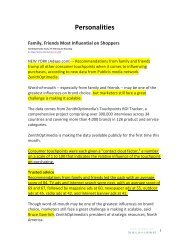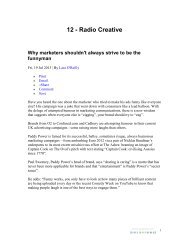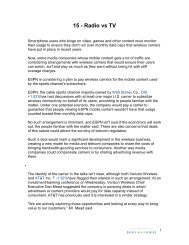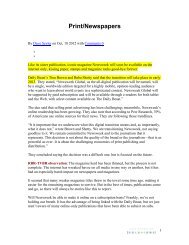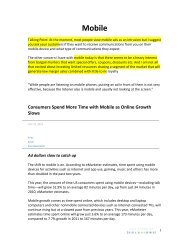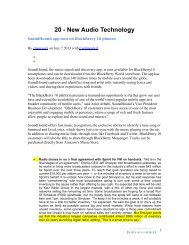- Page 1 and 2:
Summary1
- Page 3 and 4:
thus, are struggling to respond to
- Page 5 and 6:
mobile.‖And, CMOs must understand
- Page 7 and 8:
The earliest mobile advertising too
- Page 9 and 10:
The upheaval that the Internet has
- Page 11 and 12:
But when we ask respondents whether
- Page 13 and 14:
―The most significant issue for a
- Page 15 and 16:
Mobile Internet advertising is the
- Page 17 and 18:
How? With ads that are native to th
- Page 19:
There's an onus on publishers to im
- Page 23 and 24:
Some mobile analysts mistakenly bel
- Page 26:
He may even catch the tail-end of t
- Page 30:
In these campaigns, users don‘t s
- Page 34:
Unaided brand recall was 43% for au
- Page 38 and 39:
The technical hurdles are formidabl
- Page 41 and 42:
Privacy IssuesApple has now phased
- Page 44:
Google has the same complaint in th
- Page 47 and 48:
Mobile‘s usefulness for shopping
- Page 49 and 50:
1) CPG is adopting mobile faster th
- Page 51 and 52:
Performance-based pricing models ar
- Page 53 and 54:
eMarketer expects mobile video adve
- Page 55 and 56:
Listen To The Sound Of My VoiceA vo
- Page 57 and 58:
A new report investigating consumer
- Page 59 and 60:
The next day, Foursquare announced
- Page 61 and 62:
Expand context beyond locationLocat
- Page 63 and 64:
Using this tool, VocalizeMobile was
- Page 65 and 66:
the brands I see in commercials and
- Page 67 and 68:
"It's not just about trying to move
- Page 69 and 70:
―Mobile is becoming one of the fo
- Page 71 and 72:
time on a mobile device) could be r
- Page 73 and 74:
―travelers,‖ ―parents‖ and
- Page 75:
Failing to Connect with Users Durin
- Page 78 and 79:
Location is a big deal. For the his
- Page 80 and 81:
Adfonic, abuying platform for mobil
- Page 82 and 83:
media-consuming device. But what th
- Page 84 and 85:
Whether or not mobile users will be
- Page 86 and 87:
advertisers are coming to us for cu
- Page 88 and 89:
and an increased desire among custo
- Page 90 and 91:
7. Mobile Puts The “R” in Retai
- Page 92 and 93:
SoLoMo: Time to Get Social, Think L
- Page 94 and 95:
Companies and marketers who want to
- Page 96 and 97:
Making the most of a mobile video p
- Page 98 and 99:
―Since mobile rich media ad servi
- Page 100 and 101:
Triton Digital Chief Operating Offi
- Page 102 and 103:
mobile-centric ad unit? It seems cl
- Page 104 and 105:
The study goes on suggesting that t
- Page 106 and 107:
An overwhelming majority—92%- of
- Page 108 and 109:
―I think progress is being made
- Page 110 and 111:
Google also posted better-than-expe
- Page 112 and 113:
Mobile has also added another layer
- Page 114 and 115:
Facebook.Stock has climbed from und
- Page 116 and 117:
IAB: Almost two-third of mobile vid
- Page 118 and 119:
Mobile Marketing Analytics Are Diff
- Page 120 and 121:
There is gold waiting in every mobi
- Page 122 and 123:
Mobile ticketingParamount is runnin
- Page 124 and 125:
Digital Dimes to Mobile PenniesNow
- Page 126 and 127:
evenues in the third quarter after
- Page 128 and 129:
128
- Page 130 and 131:
Other research showed that TV ads w
- Page 132 and 133:
Lockhorn continued that monetary ch
- Page 134 and 135:
Among smartphone owners who havenev
- Page 136 and 137:
Display Ads' Dubious In-View Perfor
- Page 138 and 139:
We've heard Pandora CEO Joe Kennedy
- Page 140 and 141:
Talking Point: At the moment, most
- Page 142 and 143: ―Make one Web - ensure content an
- Page 144 and 145: Companies such as Amazon, Starbucks
- Page 146 and 147: 4. Mobile advertising performs poor
- Page 148 and 149: Recent developments meant to addres
- Page 150 and 151: 150
- Page 152 and 153: 152
- Page 154 and 155: demographic reported having made at
- Page 156 and 157: effectiveness, a banner click rate
- Page 158 and 159: Digital Experts Tell Us The 7 Bigge
- Page 160 and 161: The other concern I have with mobil
- Page 162 and 163: This shift has been problematic for
- Page 164 and 165: The 1800-Flowers mobile siteWith th
- Page 166 and 167: Measuring mobile video beyond the c
- Page 168 and 169: entries and then tries to provide r
- Page 170 and 171: “It brings together the best of b
- Page 172 and 173: 172
- Page 174 and 175: campaigns conducted between Novembe
- Page 176 and 177: uild big money off of it," said Man
- Page 178 and 179: But an effective way of combating u
- Page 180 and 181: Analog 54% 36%Digitally influenced
- Page 182 and 183: etailers’ recent efforts to scale
- Page 184 and 185: That‘s a lot of consumer data to
- Page 186 and 187: As mobile display advertising matur
- Page 188 and 189: Mobile devices‘ smaller screens a
- Page 190 and 191: The YP study shows that the sweet s
- Page 194 and 195: Like similar studies before it, AdS
- Page 196 and 197: percent. Trademob found that 22 per
- Page 198 and 199: 198
- Page 200 and 201: We Took Control Away4-day mobile im
- Page 202 and 203: Statistics for the current year sug
- Page 204 and 205: Key takeaways from the forecast:Spe
- Page 206 and 207: 52% of marketers report that they a
- Page 208 and 209: Data from ScanLife’s “Mobile Ba
- Page 210 and 211: vs. 10%); making a purchase on a mo
- Page 212 and 213: Challenge Marketers on MobileAUGUST
- Page 214 and 215: Marketers that push creative bounda
- Page 216 and 217: Implications- If we had used the st
- Page 218 and 219: uying against content or even vast
- Page 220 and 221: action with a brand; however, it‘
- Page 222 and 223: was relevant to them, making this t
- Page 224 and 225: MOBILE INTERNET USE ACCOUNTED FOR 1
- Page 226 and 227: ADVERTISERS, SHE CLAIMS. HOWEVER, A
- Page 228 and 229: Study: More Users Clicking Ads, Ris
- Page 230 and 231: Distrust, Irrelevance Temper Mobile
- Page 232 and 233: About The Data: The 2012 Hipcricket
- Page 234 and 235: topping the list in terms of consum
- Page 236 and 237: Foursquare, about to celebrate its
- Page 238 and 239: Here are the top tasks in terms of
- Page 240 and 241: 25.2% Newsstand (12)23.7% Lifestyle
- Page 242 and 243:
According to Nielsen the majority o
- Page 244:
244





